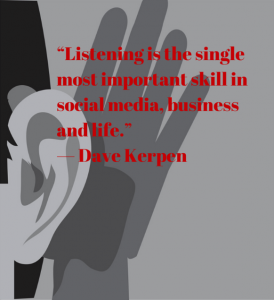#INBOUND14 takeaways, part 2: listen, empathize, connect
In my last post, I shared some inspiration from profound speakers at HubSpot’s content marketing conference, INBOUND 2014. Today I’d like to take a closer look at one of the recurring themes and what we as marketers can do to improve our efforts.
It’s common knowledge that good communicators are also good listeners. But as marketers (and perhaps creatures of habit), we tend to forget this fact and jump at the chance to talk about our product to anyone who even looks in our direction. So how can we listen more and talk less?
Create opportunities for customers and prospects to be heard
Listening doesn’t have to be a daunting task. Sometimes it’s a matter of just giving customers a sounding board for being heard. HubSpot has done such a thing for its customers by providing an online forum for any ideas on improving its marketing automation software. This isn’t just a place to
vent, it’s a platform that empowers customers to be a part of making the software better. Ideas that are in the process of being implemented even have a status update, such as “pending” or “in development” to let customers know someone on the other end is really listening to their wants, and better yet, doing something about them.
Maybe you don’t have the resources to create an online customer sounding board. Luckily, you can also use online platform Quora to ask just about anything and get a string of responses. You could also join related LinkedIn groups and poll the members. I recommend avoiding product-focused questions and sticking with true content best practices of solving problems.
Listen to what’s already being said about your product and industry
The good, bad and ugly are in plain sight for millions to see via Facebook, Google+, Twitter, Instagram, LinkedIn, etc. Every day, your customers and prospects create individual opportunities for a one-to-one, real-time conversation.
Once you have some data to work with, you’re well on your way to becoming a better marketer. But before you jump in with a response or initial message, be sure it is focused on the prospect’s issue, and not a sales goal or quota. That’s where empathy comes in.
Empathize before you even think of communicating
In a world where angry customers record service calls and share their horrible experiences with millions, not having empathy can cost you thousands of customers and a loss of trust in the marketplace. Although empathy is important in addressing complaints in the customer phase, it’s something that should be ingrained into every communication for every stage of the buyer’s journey.
Mapping personas to the buyer’s journey will provide a strong guideline for providing the appropriate level of selling (which is still pretty minimal). But there’s yet another tool for hitting someone on an emotional level, as opposed to over the head with your product features — “empathy maps.” These maps are meant to be populated in a group made up of your salespeople, vendors and other key stakeholders. Broken into four quadrants for thinking, feeling, doing and seeing, empathy maps then become littered with sticky notes as the group drills down on various aspects of the persona’s life, job role, concerns, fears and other factors — think of them as a personas on steroids.
Of course you wouldn’t do this exercise prior to responding to a social media post or customer comment. But by having all of your sales and marketing team members fully informed of your buyer personas and their pain points, crafting an empathetic response to whatever a customer or prospect throws your way (in real-time!) should become second nature.
Respond even when the comment is negative
Social media has made it easier than ever to engage with millions of customers and prospects. But before you respond to a comment, be sure that you or your sales team has empathy for the person(s) on the receiving end. Otherwise, you come on too strong and sales-y or as if you don’t care at all. Ignoring comments is not a good way to go either. According to Likeable Local CEO, David Kerpen, not responding to a social media comment is like hanging up on someone in front of thousands of people.
If social media comments are negative, it’s best to diffuse the situation with a short, empathetic response on social media and invite the customer to handle the situation with you privately.
“I understand. I care. I’m here to help.” These are what readers walk away with no matter which words are actually used.
Have any success (or crash-and-burn) experiences in communicating
with your customers? We’d love to hear them. Please send them my way along with any questions you may have about building customer relationships to heather@rep-ink.com.










[…] your employees. They should be properly trained in not only your products and services, but also listening and empathizing. Identifying a customer by their persona should also be second […]